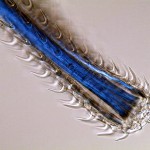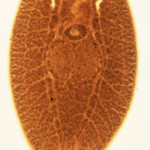As the winds blow across the vast oceans they create a symphony of waves, whose pitch may range from ripples to rogues. Eventually all waves will break, crashing wildly on the shore or fading away slowly far from land. But some wind waves meet their demise faster than others. Their strength is leeched away by one they would never think to suspect, another wave. My friends, meet the parasitic capillary wave, the vampire of wind wave energy.
Just like their biological brethren, parasitic capillary waves benefit at the expense of another. In this case, it is wind waves. Forming on the downwind face of short wind wave, parasitic capillary waves appear as tiny ripples. True to their name, these small parasitic capillary waves suck energy away from the larger wave they travel upon. Even more insidious, the parasitic waves are actually spawned by their host! Short wind waves have no one but themselves to blame for this terrible infestation.

In physics, you learn the speed of a wave is dependent upon its wavelength. And if you were to follow this logic, you would think to yourself, “larger wind wave, why don’t you just flee your tiny parasite with your superior velocity?!” But alas, in a fatal twist of physics, the host wave can not outrun its parasite. A slightly different set of rules governs the way each of these waves move. The larger wind wave is dominated by the force of gravity, while the smaller capillary waves is dominated by surface tension.* It is this tiny difference that causes the crests of both waves move at the same speed, in other words they have the same phase velocity. You can run wind wave, but you can’t hide from your parasite.
While these parasites are capillary waves, not all capillary waves are parasitic. Unless you have been living under a rock lobster, you have seen capillary waves before. The circular crests that spread from a single raindrop hitting the water surface, that’s a capillary wave. Faint ripples when the wind gently blows over water, that’s a capillary wave. The zen is high when watching these waves.
[h/t to fuckyeahfluiddynamics for the slow-mo raindrops]
Now that we have had our soothing moment of tripped-out ripple viewing, let’s get back to the big effects these tiny waves can have. Sensing the ocean with your microwave satellite? Capillary waves have similar wavelengths to microwaves, messing up your signal. Looking at the exchange of gasses between the air and the sea? Capillary wave crests and troughs increase the sea-surface area, affecting air-sea exchange and even trapping bubbles. Battling a chemical spill by releasing a surfactants into the sea? Capillary waves will redistribute that soap into dense and dilute patches. But surfactants also fight back, by changing the surface tension of water they affect whether capillary waves will even be formed.
Next time you are out at sea and the winds start to blow, please remember, those tiny ripples on the face of a wave, they’re not cute, they’re eating that big wave alive.
*Unless you are a gravity-capillary waves, whose motion is governed by gravity and surface tension. But I just chose to keep it simple here.
SOURCES:
Ceniceros, Hector D. “The effects of surfactants on the formation and evolution of capillary waves.” Physics of Fluids 15 (2003): 245.
Gade, M., W. Alpers, S.A. Ermakov, H. Hühnerfuss, and P.A. Lange, 1998: Wind-wave tank measurements of bound and freely propagating short gravity-capillary waves, J. Geophys. Res., 103, 21697-21710.
Zhang, Xin. “Capillary-gravity and capillary waves generated in a wind wave tank: Observations and theories.” Journal of Fluid Mechanics 289 (1995): 5-28.
Zhang, Xin. “Enhanced dissipation of short gravity and gravity capillary waves due to parasitic capillaries.” Physics of Fluids 14 (2002): L81.






I am reminded of cross swells.
http://www.surfersvillage.com/surfing-news/52113#.UnJGLJHFCi0
It’s the plaid of the ocean! I’ve never seen that before, thanks for sharing
It’s not the propagation velocity of a wave that depends on wavelength – that’s a property of the medium. The “speed” here is the frequency of oscillation, in this case, how fast the wave is going up and down.
You are thinking of nondispersive waves such as sound and electromagnetic waves, whose speed is independent of wave number but dependent on density of the medium they are propagating through. All the waves in this article are dispersive, meaning their speed is a function wavelength.